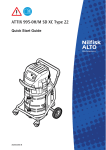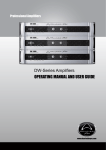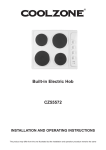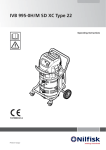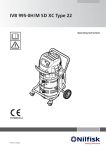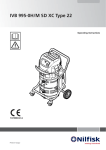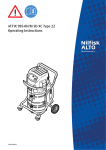Download Coolzone CZ55556 Operating instructions
Transcript
Built-in Frameless Ceramic Hob CZ55556 INSTALLATION AND OPERATING INSTRUCTIONS The product may differ from the one illustrated but the installation and operation procedure remains the same Contents Introduction Unpacking Before Installation Location Electricity Supply Cut-out Electrical Connection Fitting the hob Preparation Safety notes Using the hob Pan types Care of hotplates Cleaning the hob Troubleshooting guide Safe hob disposal Customer Helpline Specification 3 3 3 4 5 5 6 7 7 8 9 10 10 10 11 Back page Back page Back page Introduction This quality appliance has been designed to provide trouble-free service provided it is installed and maintained correctly. This hob is for domestic use only. Please read these instructions carefully before installing or using your appliance. It is advisable to keep your purchase and installation receipts with these instructions in a safe place for future reference. Included is some important safety information in addition to guidelines and recommendations to enable you to safely use your hob. This appliance has been tested and certified to meet all applicable UK electrical and safety standards. This appliance must be installed and connected by a qualified electrician in accordance with current installation regulations. This appliance must only be installed and repaired by qualified electricians or authorised service personnel. If it is not installed and repaired properly you could be putting yourself and others in danger. It will also invalidate the guarantee. If you have any questions or need assistance, please telephone the Helpline on 0844 871 0011. When contacting the Helpline, please have the model number to hand. Unpacking Carefully remove all the packaging and lift out the unit. Check the appliance for any damage. If the unit has been damaged do not use it and contact the retailer from whom the appliance was bought. Retain the packaging until the unit has been installed, removing it from the area of installation and keeping it out of the reach of children. Dispose of all the packaging in accordance with your local authority guidelines as well as the old appliance that is being replaced – see safe hob disposal section. Before installation Before any installation work can be carried out a number of requirements must be met. Make sure that you or your installer are familiar with all the relevant building and fire regulation requirements before choosing the location of your appliance. This appliance must be installed in accordance with the instructions to validate the guarantee. This appliance must not be installed in a bed-sit room of less than 20 m sq. Refer to the “Location” section for minimum clearances and safe placement of your hob. 3 Location 650mm MIN 15 0m m 400 mm MIN MI N 60 MI mm N m m 50 Figure 1 – location dimensions Position of the hob The hob must be installed into a work surface, fitted with an opening cut into the surface so that the top plate sits flush with the surface. It is best positioned directly above a 600mm wide fitted kitchen cabinet. Avoid installing the appliance next to a fridge, freezer or boiler. Gently rest the unit on a surface and determine the exact position of your appliance as follows: Safety Requirements Ensure that the surrounding material is heat resistant and non-combustible. The electricity supply must be routed near to the installation. There must not be any plugs wires or sockets in the wall directly above the hob. Clearance space Certain minimum clearances must be allowed for when planning the unit’s location (Figures 1 and 2): Beneath the work surface, allow the required clearance for appliances or units to be installed below. There should be an open space above the hob to allow kitchen odours to disperse. A cooker hood may be installed to either absorb or extract the odours. The distance between the hob and the hood must not be less than 650mm (Figure 1). The distance between the hob and the back edge of the worktop should be no less than 50mm (Figure 1). Leave adequate clearance between the hob and adjacent cupboards (no less than 150mm.) To ensure that the hob is properly supported, the distance between the hob cutout and the worktop end should be no less than 60mm (Figure 1). Ensure a gap of not less than 400mm between overhanging cupboards. It is best if the hob is surrounded by a work surface, giving safe space to rest a hot pan and space to turn handles so that they do not protrude into the walkway or become too hot over a neighbouring hotplate. 4 Electricity supply Once a satisfactory location has been established, the electrical supply to the appliance must be arranged beneath the work surface. The mains voltage must correspond to that which is specified on the data plate. The supply should be from a 45 amp fused spur, with an isolator switch installed above the work surface and to one side of the unit in case of an emergency. The isolator switch must have working contacts separated by 3mm. This installation must be carried out in accordance with current I.E.E Wiring Regulations and Building Regulations (Part P). The mains supply cable from the isolator to the unit must be rated for the maximum power consumed by the unit (also specified on the data plate). The supply cable must be long enough to reach the far side of the hob, plus an extra 750mm of slack to allow for removal and servicing. The supply cable must be routed away from hot surfaces. Cut-out Once you have ensured that safety requirements are met, minimum clearances have been observed, and electrical supplies to the unit have been arranged, installation can begin. A cut-out can be marked out on the surface as follows: 1. Cover the approximate area for the cut-out with masking tape. 2. Position the unit face down on the surface, ensuring that the top plate is exactly centred above the 600mm kitchen cabinet supporting the worktop, and that you have the correct clearance spaces around the hob. 3. Draw round the hob to mark the space that will be taken up by the top plate on the work surface. 4. Lift the unit away to a safe distance, and check that the outline produced corresponds with the hob dimensions (580 x 510) in Figure 2. 5. Mark the cut-out (550 x 480 as in Figure 2) onto the masked work surface. The cut-out line should be in a central position so that there is an even space of 15mm between the cut-out shape and the hob outline, all the way round (Figure 3). 6. Ensure that no pipes, hoses or wires are present as obstructions below the worktop, then cut the opening into your work surface exactly where you have marked the cut-out shape (Figure 4). 7. Remove the tape and ensure the area is clean and free of dust and debris. 8. Carefully lift the hob and place it into the cut-out opening to check for a good fit. Do not clamp the unit into place yet as arrangements must be made to connect the unit to its electricity supply. 580 mm m 0m 51 HOB OUTLINE CUT-OUT SHAPE m 0m 8 4 550 mm Figure 2 Figure 3 5 15mm Electrical Connection The hob must be properly connected to the mains supply by a qualified electrician according to current safety regulations. This appliance must be earthed. 1. Lift up the cover (Figure 4). 2. Loosen the cable clamp (Figure 4). 3. Connect the mains supply cable to the terminal block on the hob using the following colour code (Figure 4): • The yellow/green wire should be connected to the earth terminal identified E. • The blue or black wire should be connected to the neutral terminal, marked 4. • The brown or red wire should be connected to the live terminal, marked 1. Secure the cable clamp. Check the cable terminals for tightness and ensure that the terminal links are in place, then close the cover over the terminal block. COVER NEUTRAL TERMINAL LIVE TERMINAL EARTH TERMINAL CABLE CLAMP Figure 4 6 Fitting the hob Once the hob has been connected to its electricity supply, it can be fitted into position as follows: 1. Place the hob upside down on an adjoining surface. 2. Fit the clips onto the hob by sliding the notched end into the slot and loosely screwing the screw into the screw-hole (Figure 5). Turn the clips round so that they are in line with the hob (Figure 6). 3. Make sure that the underside edge of the hob is clean and dry. 4. Stick the foam sealing strip around the underside of the hob, 5mm in from the edge, removing the adhesive backing as you go (Figure 6). When the sealant has been stuck round all four sides and meets up with itself, trim off any excess sealing strip, leaving a neat join. 5. You may wish to add a thin bead of clear silicone sealant around the underside edge of the hob. 6. Turn the hob over and place it in centralised position in the cut-out hole, making sure that the electricity supply cable is clear of the base of the hob and any other possible heat source. 7. Turn the clips, making sure that the clips grip the worktop, and then tighten the screws (Figure 7). 8. If necessary, finish the bead of sealant with a suitable tool while it is still workable. SCREW CLIPS CLIP SLOT SCREW-HOLE FOAM SEALING STRIP Figure 5 Figure 6 CLIP CLIP SCREWS Figure 7 Preparation 1. Remove any stickers and glue from the surfaces of the hob with warm water and washing-up liquid. 7 Please read safety notes before using the hob • Never leave children unsupervised where the hob is installed as the appliance will get hot during and after use. • Make sure you understand what the controls do before using the hob. • Always turn off the hotplates when not in use • Never allow anyone to sit or stand on the hob or the surrounding work surface. • Always be careful when operating the hob and take care to avoid touching the hot plates • Never store chemicals, food stuffs or pressurised containers in cabinets above or next to the hob. • Ensure that the cables of other household appliances used near the hob are away from the hotplates • Never place flammable or plastic items on or near the hob. • Place pans centrally on the hotplates and position them so that the handles cannot accidentally be caught or become heated by other hotplates • Never use the hob as a room heater. • Never use the hob to dry clothes and tea-towels or for any other purpose than the cooking of food. • Keep the hob clean as a build up of grease or fat from cooking can cause a fire. • Allow the hob to cool before cleaning. Fire Safety Never fill a deep fat frying pan more than 1/3 full of oil Do not leave unattended while cooking! In the event of a cooking pan fire: 1. Turn off the hob at the electricity wall socket 2. Cover the pan with a fire blanket or damp cloth 3. Leave the pan to cool for at least an hour before you try to move it. Never use a fire extinguisher to put out a pan fire (the force of the extinguisher could tip the pan over.) Never use water to put out oil or fat pan fires. 8 Using the hob Before using your hob for the first time: Read the operating and safety instructions thoroughly Before switching on a hotplate, make sure that the selector knob you are using corresponds to the hotplate you wish to switch on (Figure 8). WARNING: If the ceramic surface becomes cracked, disconnect the appliance from the mains supply and do not use until repaired by a qualified technician. The hot plates The hot plate power is regulated with a 7 position temperature selector knob. The control allows for the efficient transfer of heat to the cooking pan. (Figure 9). The selector knob can be turned in both directions: • Anti-clockwise to increase heat • Clockwise to decrease heat There are numbers 0 to 6 marked on the knobs (Figure 9). These numbers correspond to the heat setting of the hot plate. • 6 is the highest setting • 0 is OFF. 3 2 4 1 4 3 2 1 Figure 9 Figure 8 9 Pan types For best results and good use of energy: • Use good quality cooking pans with thick flat bases. This gives the most efficient energy transfer from the hotplate • Never use recessed or ridged base pans. This wastes energy and gives a longer cooking time • If the diameter of the pan is too small, energy is wasted • Use pans of the correct diameter. The base should be about the same size as the hotplate • Do not place lids on the hotplates. • Use pans which are large enough for the amount of food being cooked to ensure that they do not boil over and cause unnecessary cleaning. • Do not heat an empty pan on the hotplates, as this will damage and discolour the cooking surface at the bottom of the pan. • Use a correctly fitting lid when boiling or stewing to contain heat and improve boiling times. Care of hot plates Never turn the hot plate on before placing a pan on it. Never sprinkle cold water onto a heated hotplate. Do not allow spills to be burnt onto the hotplate since baked stains are very difficult to remove. Keep the hotplates clean. A dirty hotplate does not transfer heat efficiently. Avoid placing wet pans onto the hotplates. Never use the hot plates for preparing foods wrapped in aluminium foil or in plastic pans, or place any plastic trays etc. on the hotplates. Cleaning the hob WARNING: Switch off the hob at the mains isolator switch before cleaning. Clean the hob regularly to maintain its working condition and appearance. Clean it when it is cold. When cleaning the hob, do not use harsh abrasives, caustic cleaners or sharp objects. The surface of the hob should be cleaned with warm soapy water. If the stains are difficult to remove use a cleaner specifically made for ceramic hobs and carefully follow the instructions. 10 Troubleshooting guide If you are experiencing problems with your hob, check the following problems and solutions below before contacting the Helpline. Solution Problem Check that: Nothing works. The main hob wall switch is switched to ON. Other appliances are working, to determine if there is general power failure. The circuit breaker in the distribution box has not tripped. Hotplates are slow to boil or will not simmer. Check that your pans conform to the recommendations in these instructions. Marks appearing on hotplates. The ceramic surface can be cleaned with warm soapy water or a cleaner specifically made for ceramic hobs (please refer to the care and cleaning section for more information). 11 Safe hob disposal To help the environment, Local authority instructions should be followed for the disposal of your product This appliance/fitting is marked according to the European directive 2002/96/EC on Waste Electrical and Electronic Equipment (WEEE). By ensuring this product is disposed of correctly, you will help prevent potential negative consequences for the environment and human health, which could otherwise be caused by inappropriate waste handling of this product. The symbol on the product, or on the documents accompanying the product, the Crossed Out Wheelie Bin symbol, indicates that this appliance/fitting may not be treated as household waste. Instead it shall be handed over to the applicable collection point for the recycling of electrical and electronic equipment. Disposal must be carried out in accordance with local environmental regulations for waste disposal. For more detailed information about treatment, recovery and recycling of this product, please contact your local authority, your household waste disposal service or the retailer where you purchased the product. Customer Helpline For help and assistance regarding your appliance please telephone 0844 871 0011. Specification Power supply: 230V ~ 50Hz Hotplates: 2x1200W; 2x1800W Total: 6000W Customer Service, Unit B1, Senator Point, South Boundary Road, Knowsley, LIVERPOOL L33 7RS HELPLINE TEL: 0844 871 0011 Monday to Friday (8.30am to 5pm) We continuously try to improve our products for the benefit of our customers. For this reason we reserve the right to make changes to any product at any time, without notice. Instructions ref MM26809/150108 © 2008














